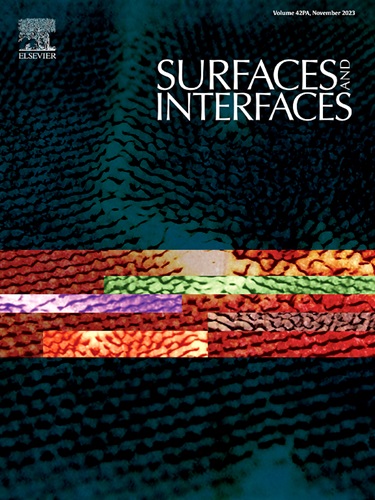Photostable hollow core-shell ZnSe@PDA-7 type-II heterojunction with built-in electric field for efficient photocatalytic generation of H2O2
IF 5.7
2区 材料科学
Q2 CHEMISTRY, PHYSICAL
引用次数: 0
Abstract
Various strategies have been developed to prevent electron-hole recombination and photocorrosion in sulfur-based semiconductors, improving catalyst efficiency and enabling high-activity, stable photocatalytic H2O2 generation. In this study, we construct a hollow core-shell catalyst by tightly coating hollow ZnSe microspheres with an organic semiconductor polydopamine (PDA) via a self-polymerization method, effectively reduces the impact of photocorrosion on ZnSe. DFT calculations confirmed the formation of a built-in electric field at the ZnSe/PDA interface, which, under its influence, promotes the creation of a type-II heterojunction favorable for photocatalytic H2O2 generation. The built-in electric field and type-II heterojunction enhance charge carrier transfer and separation. The PDA coating also improves O2 adsorption and light utilization of ZnSe, further enhancing H2O2 photocatalytic performance. Results show that ZnSe@PDA-7, with optimal PDA loading, achieves an H2O2 generation rate of 1978.5 μmol g-1 h-1 under visible light irradiation in pure water. This method of organic polymer coating on chalcogenide semiconductors effectively mitigates photocorrosion effects and improves charge carrier separation, offering a sustainable solution for clean energy synthesis.

光稳定的空心核壳ZnSe@PDA-7 ii型异质结,内置电场,用于高效光催化生成H2O2
为了防止硫基半导体中的电子-空穴复合和光腐蚀,提高催化剂效率,实现高活性、稳定的光催化H2O2生成,人们开发了各种策略。在本研究中,我们通过自聚合的方法将有机半导体聚多巴胺(PDA)紧密包裹在空心ZnSe微球上,构建了一种空心核壳催化剂,有效地降低了光腐蚀对ZnSe的影响。DFT计算证实,在ZnSe/PDA界面处形成了一个内置电场,在其影响下,促进了有利于光催化生成H2O2的ii型异质结的形成。内置电场和ii型异质结增强了载流子转移和分离。PDA涂层还提高了ZnSe对O2的吸附和光利用率,进一步提高了H2O2光催化性能。结果表明,在最佳PDA负载下,ZnSe@PDA-7在可见光照射下的H2O2生成速率为1978.5 μmol g-1 h-1。这种在硫系半导体上涂覆有机聚合物的方法有效地减轻了光腐蚀效应,改善了载流子的分离,为清洁能源合成提供了一种可持续的解决方案。
本文章由计算机程序翻译,如有差异,请以英文原文为准。
求助全文
约1分钟内获得全文
求助全文
来源期刊

Surfaces and Interfaces
Chemistry-General Chemistry
CiteScore
8.50
自引率
6.50%
发文量
753
审稿时长
35 days
期刊介绍:
The aim of the journal is to provide a respectful outlet for ''sound science'' papers in all research areas on surfaces and interfaces. We define sound science papers as papers that describe new and well-executed research, but that do not necessarily provide brand new insights or are merely a description of research results.
Surfaces and Interfaces publishes research papers in all fields of surface science which may not always find the right home on first submission to our Elsevier sister journals (Applied Surface, Surface and Coatings Technology, Thin Solid Films)
 求助内容:
求助内容: 应助结果提醒方式:
应助结果提醒方式:


